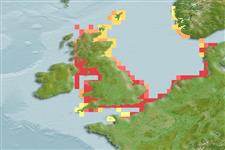Malacostraca |
Decapoda |
Palaemonidae
Environment: milieu / climate zone / depth range / distribution range
Ecology
Benthic; catadromous; freshwater; brackish; depth range 0 - 17 m (Ref. 101283). Temperate, preferred 11°C (Ref. 107945); 61°N - 27°N, 14°W - 42°E
Eastern Atlantic and the Mediterranean. Introduced in Baltic and Black Sea.
Length at first maturity / Size / Weight / Age
Maturity: Lm ? range ? - ? cm Max length : 7.0 cm TL male/unsexed; (Ref. 8)
Common in European estuaries. Mostly inhabits freshwater throughout the year but migrates to estuarine brackish waters to reproduce (Ref. 82147).
Life cycle and mating behavior
Maturity | Reproduction | Spawning | Eggs | Fecundity | Larvae
Inhabits freshwater but migrates o estuarine brackish waters to reproduce. The development of the whole larval stage takes place in mid estuarine waters (Ref. 82147); juveniles migrates back to freshwater (Ref. 82145).
Grabowski, M. 2006 Rapid colonization of the Polish Baltic coast by an Atlantic palaemonid shrimp Palaemon elegans Rathke, 1837. Aquatic Invasions 1(3):116-123. (Ref. 2756)
IUCN Red List Status
(Ref. 130435: Version 2025-1)
CITES status (Ref. 108899)
Not Evaluated
Not Evaluated
Threat to humans
Human uses
Fisheries: commercial; bait: occasionally
FAO - Fisheries: landings | FishSource | Sea Around Us
Tools
More information
Trophic EcologyFood items (preys)
Diet composition
Food consumption
Predators
Life cycleReproductionMaturityFecunditySpawningEggsEgg developmentLarvae PhysiologyOxygen consumption
Human RelatedStamps, coins, misc.
Internet sources
Estimates based on models
Preferred temperature
(Ref.
115969): 10.6 - 12.5, mean 11.5 (based on 86 cells).
Resilience
High, minimum population doubling time less than 15 months (K=0.51-0.62).
Fishing Vulnerability
Low vulnerability (23 of 100).
Climate Vulnerability
High vulnerability (64 of 100).
Nutrients : Calcium = 109 [35, 184] mg/100g; Iron = 1.59 [1.21, 1.97] mg/100g; Protein = 20.2 [19.2, 21.3] %; Omega3 = 0.285 [0.185, 0.386] g/100g; Selenium = 48.3 [-31.7, 128.3] μg/100g; VitaminA = 0 μg/100g; Zinc = 1.79 [1.17, 2.40] mg/100g (wet weight); based on
nutrient studies.
